engine Citroen C4 CACTUS RHD 2014 1.G Workshop Manual
[x] Cancel search | Manufacturer: CITROEN, Model Year: 2014, Model line: C4 CACTUS RHD, Model: Citroen C4 CACTUS RHD 2014 1.GPages: 331, PDF Size: 8.56 MB
Page 165 of 331
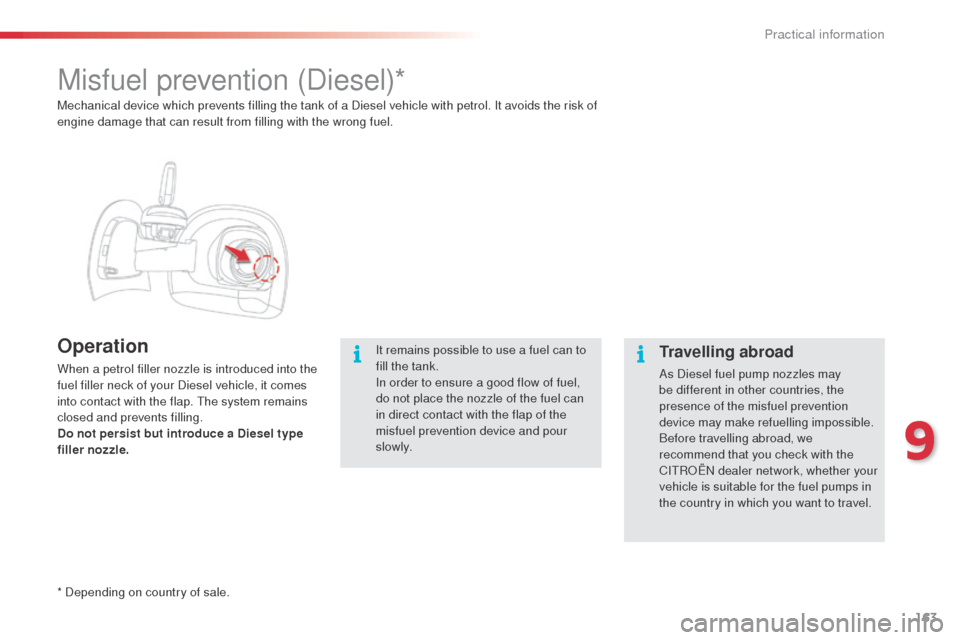
163
Misfuel prevention (Diesel)*
Operation
When a petrol filler nozzle is introduced into the
fuel filler neck of your Diesel vehicle, it comes
into contact with the flap. The system remains
closed and prevents filling.
Do not persist but introduce a Diesel type
filler nozzle.
* Depending on country of sale. Mechanical device which prevents filling the tank of a Diesel vehicle with petrol. It avoids the risk of
engine damage that can result from filling with the wrong fuel.It remains possible to use a fuel can to
fill the tank.
In order to ensure a good flow of fuel,
do not place the nozzle of the fuel can
in direct contact with the flap of the
misfuel prevention device and pour
s l ow l y.Travelling abroad
As Diesel fuel pump nozzles may
be different in other countries, the
presence of the misfuel prevention
device may make refuelling impossible.
Before travelling abroad, we
recommend that you check with the
CITROËN dealer network, whether your
vehicle is suitable for the fuel pumps in
the country in which you want to travel.
9
Practical information
Page 166 of 331

164
Quality of the fuel used for
petrol engines
The petrol engines are per fectly compatible
with E10 type petrol biofuels (containing 10 %
ethanol), conforming to European standards
EN 228 and EN 15376.
E85 type fuels (containing up to 85 % ethanol)
are reserved exclusively for vehicles marketed
for the use of this type of fuel (BioFlex
vehicles). The quality of the ethanol must
comply with European standard EN 15293.
For Brazil only, special vehicles are marketed
to run on fuels containing up to 100 % ethanol
( E10 0 t y p e).
Quality of the fuel used for
Diesel engines
The Diesel engines are per fectly compatible
with biofuels which conform to current and
future European standards (Diesel fuel
which complies with standard EN 590 mixed
with a biofuel which complies with standard
EN 14214) available at the pumps (containing
up to 7 % Fatty Acid Methyl Ester).
The B30 biofuel can be used in certain Diesel
engines; however, this use is subject to strict
application of the special servicing conditions.
Contact a CITROËN dealer or a qualified
workshop.
The use of any other type of (bio)fuel
(vegetable or animal oils, pure or diluted,
domestic fuel...) is strictly prohibited (risk of
damage to the engine and fuel system).
Practical information
Page 167 of 331

165
Running out of fuel (Diesel)
On vehicles fitted with HDi engines, the fuel
system must be primed if you run out of fuel.
e-HDi 92 engine
F Fill the fuel tank with at least five litres of diesel.
F
O
pen the bonnet.
F
I
f necessary, unclip the styling cover for
access to the priming pump.
F
S
queeze and release the priming pump
repeatedly until resistance is felt (there
may be resistance at the first press).
F
O
perate the starter until the engine starts
(if the engine does not start at the first
attempt, wait around 15 seconds before
trying again).
F
I
f the engine does not start after a few
attempts, operate the priming pump again
then start the engine.
F
C
lip the styling cover back in place.
F
C
lose the bonnet.
If the engine does not start first time,
don't keep trying but start the procedure
again from the beginning.
Blue HDi 100 engine
F Fill the fuel tank with at least five litres of
Diesel.
F
S
witch on the ignition (without starting the
engine).
F
W
ait around 6 seconds and switch off the
ignition.
F
R
epeat the operation 10 times.
F
O
perate the starter to run the engine.
9
Practical information
Page 168 of 331

166
AdBlue® additive and SCR system
for BlueHDi Diesel engines
To assure respect for the environment and
conformity with the new Euro 6 emissions
standard, without adversely affecting the
per formance or fuel consumption of Diesel
engines, CITROËN has taken the decision to
equip its vehicles with an effective system that
associates SCR (Selective Catalytic Reduction)
with a particle filter (FAP) for the treatment of
exhaust gases.
Presentation of the SCR system
Using an additive called AdBlue® containing urea,
a catalytic converter turns up to 85% of nitrous
oxides (NOx) into nitrogen and water, which are
harmless to health and the environment. Once the AdBlue
® tank is empty, a
s
ystem required by regulations prevents
starting of the engine.
If the SCR is faulty, the level of
emissions from your vehicle will no
longer meet the Euro 6 standard: you
vehicle becomes polluting.
In the event of a confirmed fault
with the SCR system, you must go
to a CITROËN dealer or a qualified
workshop as soon as possible: after a
running distance of 650 miles
(1 100 km), a system will be triggered
automatically to prevent engine starting.
The AdBlue® additive is held in a special
tank located under the boot at the rear of
the vehicle. It has a capacity of 17 litres: this
provides a driving range of about 12 500 miles
(20 000 km), after which an alert is triggered
warning you when the reserve remaining is
enough for just 1 500 miles (2 400 km).
During each scheduled service of your vehicle
by a CITROËN dealer or a qualified workshop,
the AdBlue
® additive tank is refilled in order to
allow normal operation of the SCR system.
If the estimated mileage between two services
is greater than 12 500 miles (20 000 km), we
recommend that you go to a CITROËN dealer
or a qualified workshop to have the necessary
top-up carried out.
Practical information
Page 169 of 331
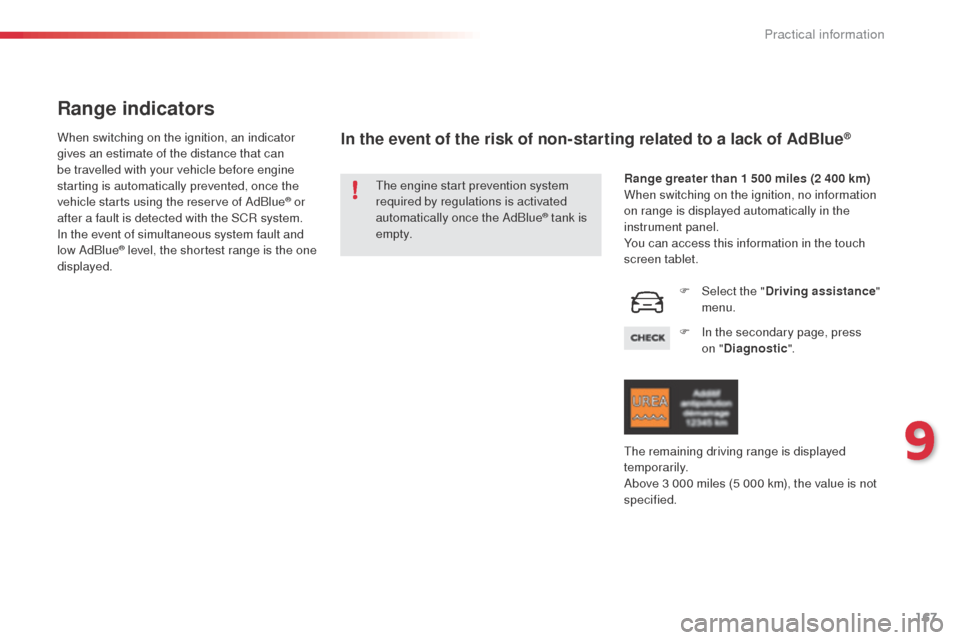
167
Range indicators
When switching on the ignition, an indicator
gives an estimate of the distance that can
be travelled with your vehicle before engine
starting is automatically prevented, once the
vehicle starts using the reserve of AdBlue
® or
after a fault is detected with the SCR system.
In the event of simultaneous system fault and
low AdBlue
® level, the shortest range is the one
displayed. Range greater than 1 500 miles (2 400 km)
When switching on the ignition, no information
on range is displayed automatically in the
instrument panel.
You can access this information in the touch
screen tablet.
The engine start prevention system
required by regulations is activated
automatically once the AdBlue
® tank is
e m pt y.
In the event of the risk of non-starting related to a lack of AdBlue®
F Select the " Driving assistance "
menu.
F
I
n the secondary page, press
on " Diagnostic ".
The remaining driving range is displayed
temporarily.
Above 3 000 miles (5 000 km), the value is not
specified.
9
Practical information
Page 170 of 331
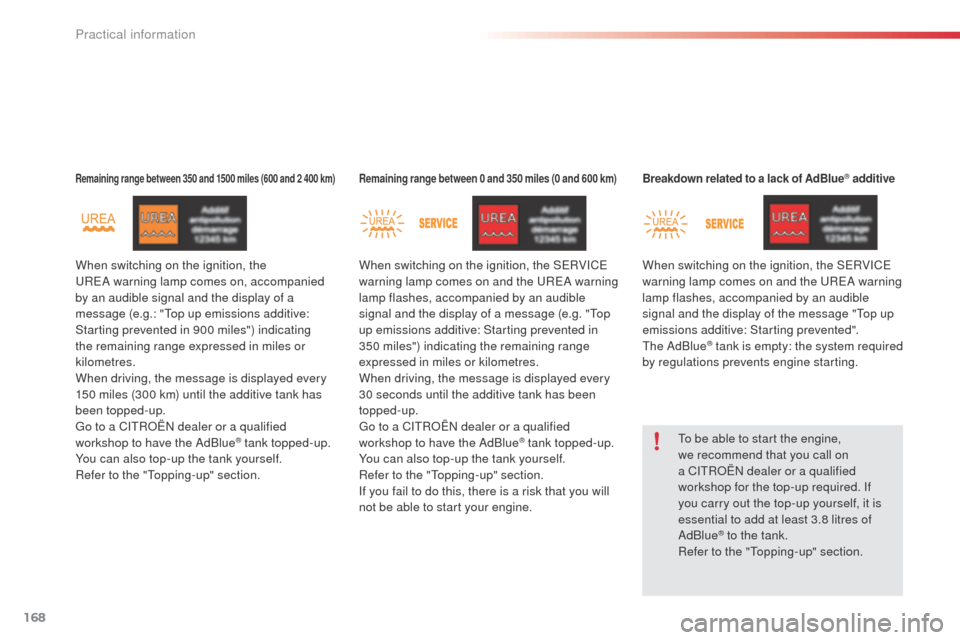
168
Remaining range between 350 and 1500 miles (600 and 2 400 km)Remaining range between 0 and 350 miles (0 and 600 km)Breakdown related to a lack of AdBlue® additive
To be able to start the engine,
we recommend that you call on
a CITROËN dealer or a qualified
workshop for the top-up required. If
you carry out the top-up yourself, it is
essential to add at least 3.8 litres of
AdBlue
® to the tank.
Refer to the "Topping-up" section.
When switching on the ignition, the
UREA
warning lamp comes on, accompanied
by an audible signal and the display of a
message (e.g.: "Top up emissions additive:
Starting prevented in 900 miles") indicating
the remaining range expressed in miles or
kilometres.
When driving, the message is displayed every
150 miles (300 km) until the additive tank has
been topped-up.
Go to a CITROËN dealer or a qualified
workshop to have the AdBlue
® tank topped-up.
You can also top-up the tank yourself.
Refer to the "Topping-up" section. When switching on the ignition, the SERVICE
warning lamp comes on and the UREA warning
lamp flashes, accompanied by an audible
signal and the display of a message (e.g. "Top
up emissions additive: Starting prevented in
350 miles") indicating the remaining range
expressed in miles or kilometres.
When driving, the message is displayed every
30 seconds until the additive tank has been
topped-up.
Go to a CITROËN dealer or a qualified
workshop to have the AdBlue® tank topped-up.
You can also top-up the tank yourself.
Refer to the "Topping-up" section.
If you fail to do this, there is a risk that you will
not be able to start your engine. When switching on the ignition, the SERVICE
warning lamp comes on and the UREA warning
lamp flashes, accompanied by an audible
signal and the display of the message "Top up
emissions additive: Starting prevented".
The AdBlue
® tank is empty: the system required
by regulations prevents engine starting.
Practical information
Page 171 of 331

169
In the event of a fault with the the SCR emissions control system
In the event of the detection
of a faultDuring an authorised driving phase (between
650 miles and 0 miles) (1 100 km and 0 km)
A system that prevents engine starting is
activated automatically from 650 miles
(1 100 km) after confirmation of a fault
with the SCR emissions control system.
Have the system checked by a CITROËN
dealer or a qualified workshop as soon as
possible.
If it is a temporary fault, the alert
disappears once the exhaust gas
emissions return to normal.
When switching on the ignition, the UREA,
SERVICE and diagnostic warning lamps comes
on, accompanied by an audible signal and the
display of a message "Emissions fault" to signal
a fault with the emissions control system.
If a fault with the SCR system is confirmed
(after 30 miles (50 km) covered with the
permanent display of the message signalling
a fault), when switching on the ignition, the
SERVICE and engine diagnostic warning lamps
come on and the UREA warning lamp flashes,
accompanied by an audible signal and the
display of a message (e.g.: "Emissions fault:
Starting prevented in 150 miles") indicating the
remaining range express in miles or kilometres.
While driving, the message is displayed every
30 seconds while the fault with the SCR system
persists.
You should go to a CITROËN dealer or a
qualified workshop as soon as possible.
If you fail to do this, there is a risk that you will
not be able to start your engine.
9
Practical information
Page 172 of 331
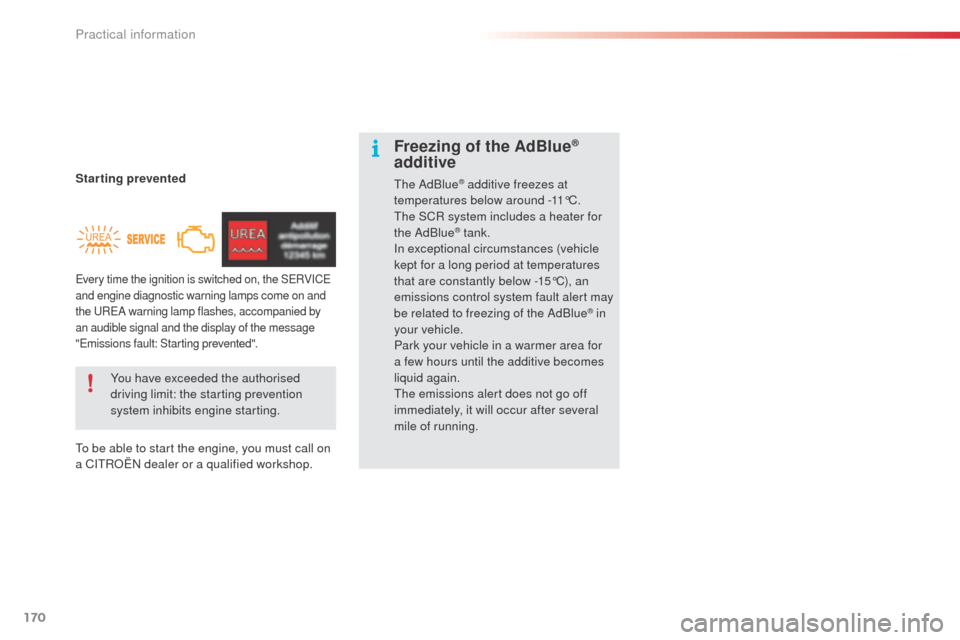
170
Starting prevented
To be able to start the engine, you must call on
a CITROËN dealer or a qualified workshop.You have exceeded the authorised
driving limit: the starting prevention
system inhibits engine starting.
Freezing of the AdBlue®
additive
The AdBlue® additive freezes at
temperatures below around -11°C.
The SCR system includes a heater for
the AdBlue
® tank.
In exceptional circumstances (vehicle
kept for a long period at temperatures
that are constantly below -15°C), an
emissions control system fault alert may
be related to freezing of the AdBlue
® in
your vehicle.
Park your vehicle in a warmer area for
a few hours until the additive becomes
liquid again.
The emissions alert does not go off
immediately, it will occur after several
mile of running.
Every time the ignition is switched on, the SERVICE
and engine diagnostic warning lamps come on and
the UREA warning lamp flashes, accompanied by
an audible signal and the display of the message
"Emissions fault: Starting prevented".
Practical information
Page 175 of 331

173
F Obtain a bottle of AdBlue®. After first
checking the use-by date, read carefully
the instructions on use on the label before
pouring the contents of the bottle into your
vehicle's AdBlue
® tank.
Important : if your vehicle's AdBlue
®
tank is completely empty - which is
confirmed by the alert messages and
the impossibility of starting the engine,
you must add at least 3.8 litres (so
two 1.89 litre bottles). If any additive is split or splashed, wash
immediately with cold water or wipe with
a damp cloth.
If the additive has crystallised, clean it
off using a sponge and hot water.
Important:
in the event of a top-up after
a breakdown because of a lack of
additive , signalled by the message "Top
up emissions additive: Starting prevented",
you must wait around 5 minutes before
switching on the ignition, without opening
the driver's door, locking the vehicle
or introducing the key into the ignition
switch .
Switch on the ignition, then, after
10
seconds, start the engine.
Never dispose of AdBlue
® additive
bottles in the household waste. Place
them in a special container provided
this purpose or take them to your dealer.
F
A
fter emptying the bottle, wipe away any
spillage around the tank filler using a damp
cloth.
F
R
efit the blue cap to the tank and turn
it a 6
th of a turn clockwise, to its stop.
F
R
efit the black cap and turn it a quarter of
a turn clockwise without pressing. Ensure
that the indicator on the cap lines up with
the indicator on the support.
F
D
epending on equipment, return the spare
wheel and/or the storage box to the bottom
of the boot.
F
R
efit the boot carpet and close the tailgate.
9
Practical information
Page 178 of 331
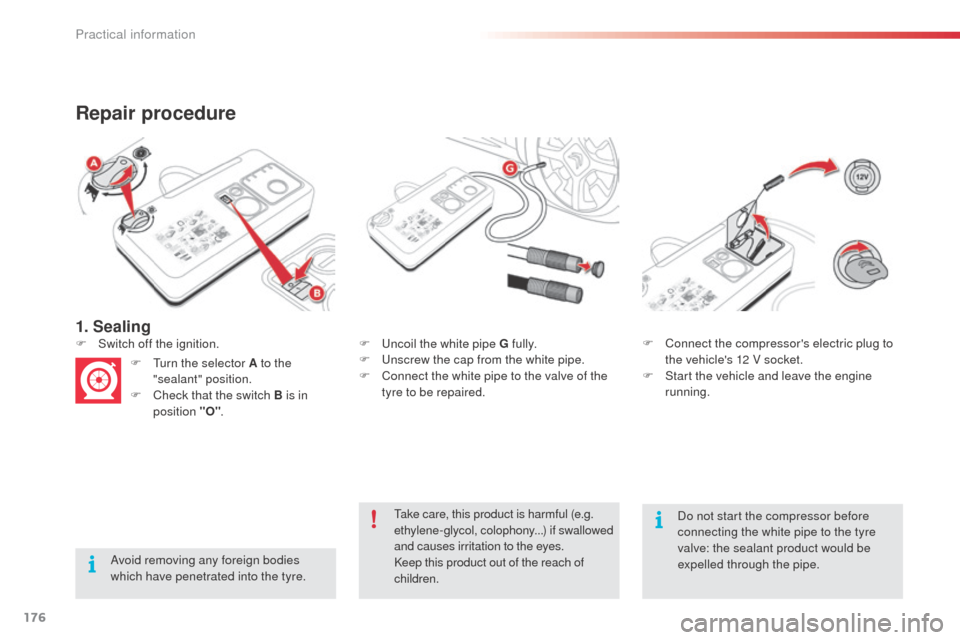
176
1. Sealing
Repair procedure
Avoid removing any foreign bodies
which have penetrated into the tyre.F
U
ncoil the white pipe G fully.
F
U
nscrew the cap from the white pipe.
F
C
onnect the white pipe to the valve of the
tyre to be repaired.
F
S
witch off the ignition.
F
T
urn the selector A to the
"sealant" position.
F
C
heck that the switch B is in
position "O" . F
C
onnect the compressor's electric plug to
the vehicle's 12 V socket.
F
S
tart the vehicle and leave the engine
running.
Take care, this product is harmful (e.g.
ethylene-glycol, colophony...) if swallowed
and causes irritation to the eyes.
Keep this product out of the reach of
children. Do not start the compressor before
connecting the white pipe to the tyre
valve: the sealant product would be
expelled through the pipe.
Practical information